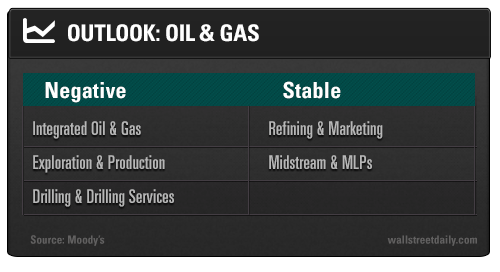The downturn in commodities has rippled across all asset classes, especially the credit markets.
There’s no light at the end of the tunnel, either, as Moody’s Investors Service sees more negativity ahead.
On February 4, Moody’s presented its findings in a panel sponsored by the Fixed Income Analysts Society (FIASI), entitled “Commodity Downturn Intensifies.”
According to Group Credit Officer Mariarosa Verde, the commodity crisis is occurring during a more mature credit cycle. That means growing stress among commodities poses a great danger to the cycle itself.
After several years of declining commodity prices, the pace of deterioration has accelerated in recent months. Plus, a disappointing outlook for global economic activity coupled with slowing demand from China means supply and demand won’t be rebalanced anytime soon.
The futures markets serve as a chilling indicator. Forward curves of most commodities are flat, supporting Moody’s view that this downturn will last a long time.
Meanwhile, investor exposure to the commodities sector is significant, a result of surging global debt sold to finance capacity expansion in recent years.

Needless to say, the price collapse in commodities has profoundly impacted the credit quality of oil and gas as well as metals and mining companies, culminating in numerous downgrades.
In fact, oil and gas and metals and mining companies account for half of non-financial speculative grade defaults in 2015.
And Moody’s believes that credit quality will deteriorate even further this year, exacerbated by sharply lower expectations for commodities prices over the next few years.
In January alone, Moody’s placed an additional 102 energy and 55 mining companies under review for downgrade.
One main reason is that hedging agreements are set to expire this year, liquidity cushions are eroding, and access to capital remains limited. More companies will need to restructure untenable debt through a combination of distressed exchange transactions or bankruptcy filings.
The commodity crisis has also put additional pressure on the global corporate rating mix. As such, default rates for corporate issuers are expected to increase as investors shy away from higher risk credits.
Today, about 60% of ratings are speculative grade. But as that universe grows, so does the potential for either longer lasting or shorter but more severe default cycles.
Energy Under Pressure
Let’s look at the energy industry in particular.
According to Managing Director Steve Wood, some of Moody’s pertinent 2016 industry credit themes include an oversupply of both global oil and U.S. natural gas, a rise in distressed exchanges and defaults amid continued low commodity prices, and an increase in consolidation of merger and acquisitions (M&A) activity due to uncertainty surrounding the commodity price recovery.
Moody’s also expects capital spending across exploration and production to decline at least 20% to 25%.

Yet Moody’s believes the most stressed segment will be the oil field services and offshore drilling sectors. Integrated oil and gas companies won’t fare well, either.
Master limited partnerships (MLPs) are also at risk, posing a greater challenge to the MLPs’ long record of cash flow distribution growth.
The key issue here is an oversupply that’s dampening prices.
Saudi Arabia continues to compete for market share while its equilibrium price assumes a return to a price environment that supports the development of all but the most expensive oil plays amid a lowered cost structure.
The increase in Iranian oil exports and lower Chinese demand only exacerbates the situation.
Natural gas prices in North America are weak even in the heart of winter. While high demand should help lift prices, no short-term changes are anticipated.
Natural gas liquid prices have also weakened along with that of crude oil. Moody’s expects the rapid rig count decline to show a slow recovery.
Base Metals, Steel, and Coal – Even Worse
If oil and gas looks bad, base metals, steel, and coal look even worse, with a purely negative outlook for all three. According to Managing Director Brian Oak,
“We are unwinding the excesses of the last five to six years. The minors are still jockeying for market share, but they need rebalancing, and that will take time.”
In base metals, even with falling London Metal Exchange (LME) inventory levels, prices are still depressed and weakening.
As for steel, China is oversupplied, and the U.S. capacity utilization is so weak that no steel company is currently making money.
Coal, however, is the most stressed sector, with both thermal and metallurgical coal in a secular decline for years. The U.S. share of electricity from coal is expected to fall to 30% from almost 50% in 2007.
On January 21, Moody’s placed 55 global mining companies rated A1-B3 under review for downgrade, and many could experience multi-notch downgrades.
Moody’s never subscribed to the commodity super cycle, believing that the last run up was due to two fiscal stimuluses, low interest rates, and unrealistic expectations that China’s growth would continue.
Whether or not one does believe in the super cycle, we have a ways to go before we see it again.
Good investing,
by Shelly Goldberg
